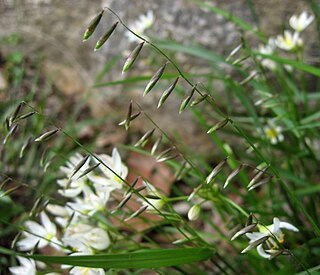Melica animarum is a species of grass that is endemic to Sierra de las Ánimas in Uruguay.
Melica longiflora is a grass species in the family Poaceae that is endemic to Chile where it can be found from Coquimbo to Talca.

Melica mutica, the twoflower melicgrass, is a grass species in the family Poaceae that can be found in southeastern United States.
Melica brasiliana, is a grass species in the family Poaceae that is endemic to Brazil and southern South America.
Melica serrana, is a species of grass endemic to Cerro de las Ánimas, Uruguay.
Melica stuckertii, is a grass species in the family Poaceae that is endemic to Argentina and southern South America.
Melica schafkatii, is a species of grass that can be found in Central Asia.
Melica dendroides is a grass species in the family Poaceae that is endemic to southern part of Africa.
Melica eligulata is a species of grass in the family Poaceae. It is native to Afghanistan, Iran, Iraq, Lebanon, Syria, and Turkey.
Melica commersonii is a species of grass endemic to Chile.
Melica hyalina is a species of grass found in Brazil and southern South America.
Melica hunzikeri is a species of grass that is endemic to southern South America.
Melica paulsenii is a species of grass endemic to Chile where it grows along the coastal cordillera at 50–700 metres (160–2,300 ft) above sea level.
Melica mollis is a species of grass endemic to Chile where it grows in rock crevices at 340 metres (1,120 ft) above sea level.
Melica minuta is a species of grass that can be found in North Africa, Western Asia, on Iberian Peninsula and in Southeast Europe.
Melica rigida is a species of grass found in Argentina, Brazil, and Uruguay.
Melica patagonica is a species of grass that is endemic to South America.
Melica parodiana is a species of grass found in Buenos Aires, Argentina and Uruguay.
Melica longiligulata is a species of grass endemic to Sichuan province of China.
Melica riograndensis is a species of grass that is endemic to Brazil.
